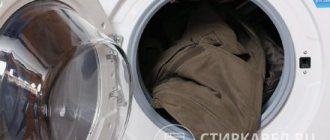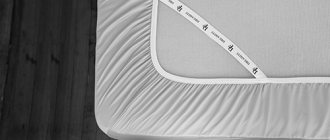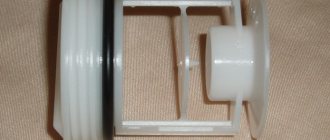Preparing for washing
Thermal underwear, which contains wool and synthetics, becomes covered with pellets after frequent washing. To prevent small balls from forming, the product must first be prepared:
Turn things inside out, with the nap inside.- Remove dirt stains with a dry brush, getting rid of sticky fibers.
- Comb the long pile against the grain and shake. Then turn it inside out.
- Study carefully the information on the model label, which indicates the water temperature, washing method, and contraindications for this product.
- On the panel of the automatic machine, the minimum rotation speed of the drum is set so that the pile does not get lost or tangled.
- The temperature is chosen no higher than 30 degrees so that the weaving threads do not stick together and melt.
- Disable spin mode.
- A basin of sufficient volume is filled with warm, soft water, in case of hand washing.
- The resulting pellets are removed with a safety razor or a special machine.
Before washing heated thermal underwear, it is recommended to follow some recommendations:
- Fasten zippers, rivets, buttons, and Velcro.
- Sew buttonholes during washing with a few light stitches to avoid stretching of the woven fabric.
- Remove heating elements and wires from special pockets so that they do not fall into the water. Shake out dust from the grooves.
- Remove all contents from pockets. So that sharp objects do not remain, which, during the rotation of the drums, tear the fabric and damage the mechanisms of washing machines.
Safe charging batteries of heated underwear are located in pockets on the lower back, shoulder blades, and front of the thigh. When contacting water, heating elements, batteries and adapters lose their functionality and are destroyed.
A current short circuit occurs in them. Therefore, before washing, they must be removed from special pockets .
Rules for washing products
Before washing thermal underwear, study the tag, which will allow you to select the water temperature and washing method.
Follow the following recommendations:
- The fleeced item is turned inside out.
- During the machine procedure, the spin function is turned off. Accordingly, they do not twist the products if the process is carried out manually.
- Use gentle detergent varieties.
- The water temperature should not exceed 40˚С.
ARTICLE FOR YOU
How to wash nylon clothes: in a washing machine and by hand
Rules for washing products
To understand how often washing should be done, the characteristics of breathable fabric are studied. Its main feature is the presence of pores that can quickly become clogged with various pollutants. For this reason, thermal fabric loses its heat-saving properties.
It is recommended to wash such products immediately after finishing intense sports training. If underwear is used for everyday wear, then every other day.
How to choose a detergent?
It is preferable to wash thermal underwear with products specifically designed for this purpose. They are somewhat more expensive, but maintain quality and carefully clean the fabric. Usually these are viscous liquids that soften water and remove static charge, which is especially important.
Recommended conditioners and specific detergents:
- Toko Eco Textile Wash;
- Grangers Performance Wash;
- NIKWAX BASEFRESH;
- Nikwax BASEWASH;
- TOKO Funktional Sportswear Care;
- Grangers Active WASH.
Simple washing powder clogs the lint of warm fabrics and wool, and microfiber holes. It is better to discard it or dissolve it thoroughly before use to get rid of hard grains.
Special cleaning solutions and gels are more economical and convenient . A big plus is that the flowable gels do not contain phosphates, which are harmful to the environment. Thanks to this, they are not capable of causing allergies. This makes it possible to wash clothes that are adjacent directly to the body in these solutions.
Angora wool and merino wool are sometimes washed with shampoo. Recently, soap nut shells have been increasingly used.
This environmentally friendly method is more convenient to use in the process of manual, gentle washing of woolen and fleecy items.
How to properly process it in a washing machine?
The prepared thermal underwear is placed in the washing machine, programmed for the following mode:
- "wool";
- "delicate wash";
- "handwash";
- "silk".
These machine operating options ensure gentle treatment of the fabric.
The delicate effect is obtained due to several factors:
- maximum volume of water;
- temperature not higher than 30 degrees;
- spin is disabled;
- A special bag is used for products that require especially careful handling.
This preserves the shape of things and extends the life of the automatic machine. It is advisable to place different parts of the kit in different laundry bags.
The machine will wash and rinse. If opaque water flows out, rinsing can be repeated several times .
Immediately after stopping the mechanism, you need to open the door and leave things inside to let the water drain out. For 10-15 minutes. Then the items are taken out of the drum and laid out on a horizontal surface for drainage.
Products made from goat down and mohair should not be machine washed. As they rotate in the drum, they fall into a lump, catastrophically decreasing in size.
Handwash
The manual washing method allows you to carefully care for thermal underwear, regardless of the characteristics of the material from which it is made. Let's look at how to wash thermal underwear by hand:
- At the first stage, water is poured into a basin at a temperature of no higher than 40°C (the exact value depends on the type of fabric), special detergent or soap is dissolved in it (not household soap - it can damage the fabric).
- The products are soaked for 10-15 minutes.
- You should wash with careful movements; you should not intensively wrinkle the item during the process or rub the folds of the fabric against each other, use a brush, etc.
- The product is rinsed 2-3 times in cool water - it is important to remove particles of detergent so that the fabric does not lose its properties.
- It is advisable not to wring out the thermal underwear, but to hang it in a net and wait until the water drains. Then the product is hung on a drying rack.
Before washing thermal underwear, check what water temperature the manufacturer indicated on the label - it may be lower than the standard 40°C.
Manual cleaning
For hand washing, you should also prepare thermal underwear. Take a deep, large-volume basin.
Warm water (30-35 degrees) should cover the items completely, and the detergent should form high foam . Then small balls will not form on the products.
The washing liquid should soften hard water and eliminate static charge.
Soak
Prolonged soaking of wool fabrics is contraindicated. The faster the entire wash is done, the better (45 minutes per process). Synthetic fabrics that are heavily soiled can be soaked for 1-2 hours before washing.
Removing stains
Heavily contaminated areas are cleaned first . To do this, the laundry is spread on a washboard lying above the bathtub. Apply a few drops of an active, oxygen-containing stain-removing product to the stain.
The product foams and removes the stain in 30 seconds. At the same time, the color and properties of the fabric are not lost.
After 30 seconds, pour a little warm (30 degrees) water onto the dirty area and gently rub the area with a soft sponge or brush. Place the laundry in a bowl with high foam and continue general washing. You can go over the disappearing stain twice with a brush with natural bristles.
What can't you do?
During the washing process, thermal underwear should not:
- twist;
- rub with great effort;
- crush strongly;
- stretch;
- boil;
- heat water above 30 degrees;
- use chlorine bleaches;
- use caustic dry cleaning substances.
Things should be carefully sorted through soapy water, shaken, and rubbed delicately. Very dirty clothes are washed in soapy water two or three times.
Rinsing
It is recommended to rinse parts of thermal underwear in a large amount of water, changing several times, until it becomes transparent.
Wash and rinse things in water of the same temperature. Otherwise the fabric will shrink.
When rinsing, clothes are tossed and tossed very carefully, without effort , so as not to disturb the complex weaving of wool and microfiber fibers:
- without twisting;
- without stretching;
- without squeezing.
Spin
Under no circumstances should you twist thermal underwear like regular cotton sheets. Otherwise, the layer of thermal underwear that allows moisture to evaporate from the body will be damaged.
To remove water from washed items, place them evenly on a washboard . Such a board is usually found in every home; it is installed on the edges of a bathtub or large trough.
The sewer drain hole is left open. If possible, turn on the air exhaust fan. Ensure good ventilation of the room by opening doors and windows so that things do not suffocate.
Parts of clothing, edges and some parts (sleeves, trouser legs) are lowered down, directing the flowing water.
Do I need to soak?
Soaking is always important when heavily soiled, and socks are no exception. If this is not done, dirt and dust can be quite firmly absorbed into the fabric fibers and then even several washing procedures will not help restore them to freshness. There are two methods to soak very dirty socks:
- 10-12 hours before washing, immerse them in a basin of warm water, in which a couple of tablespoons of powder intended for hand washing are mixed in advance. Heavy stains on light-colored fabric should be soaked with bleach.
- another “grandmother’s” method: areas that are too dirty are soaped with laundry soap and wrapped in a plastic bag overnight.
You should know that soaking should not occur in very hot water, above 40 degrees. Excessively hot water will not only not help remove contaminants, but, on the contrary, will promote the absorption of dirt particles from fabric fibers.
Instead of soaking, it is better to place very dirty white socks in a solution of water and boric acid for a couple of hours. You can make a solution by diluting 3 grams of acid per liter of water.
How often?
Items that are worn daily are washed when they become dirty . Usually two or three times a week is enough.
Athletes wash their clothes immediately after active training. Especially when thermal underwear is worn for insulation under ski suits.
Heat-protective products that contain down and fine wool, which have antibacterial properties, are not recommended to be washed frequently . Once every six months is enough. Especially if it's outerwear.
Fabrics made from synthetic, woven threads are recommended to be washed before use. After wearing, if there is no smell of sweat, this does not mean that the clothes are clean. If these items are rarely washed, they stop “breathing” and the holes between the fibers become clogged.
Details. How often to wash thermal underwear
You need to constantly care for thermal underwear, because a dirty membrane layer no longer performs its unique functions. The cells of the material are constructed in such a way as to be as close as possible to the structure of the pores of human skin. The pure material completely copies natural human heat exchange. If the honeycomb becomes clogged with keratinized particles of the epidermis and dust, then thermal underwear ceases to be comfortable.
Ordinary clothes seem stale when they smell, but the fabric structure of membrane clothing does not allow scents to linger. For this reason, the frequency of washing thermal underwear is determined based on the intensity of wear:
— models for sports are washed after training or other physical activity;
— everyday clothes are washed every 4 days;
— outerwear does not need to be washed often.
To ensure that thermal underwear does not lose its unique properties, you must adhere to the following rules:
- Products containing chlorine should not be used.
- Thermal underwear with fleece should be washed and cleaned from the reverse side.
- Do not twist the fabric or use a wringer.
- At what temperature should you wash thermal underwear? Thermal underwear must be washed at a temperature of no more than 30°C.
- Granular powders cannot be used, because small particles can get clogged into the cells. The detergent cannot be completely rinsed out, so contact with the skin may cause irritation.
REFERENCE! Manufacturers of thermal underwear advise carefully studying the instructions on product labels, which indicate the main principles of care and use.
Features for different materials
Fabrics from which thermal underwear is made:
- natural cotton;
- elastane;
- polypropylene;
- polyester;
- fleece;
- Merino sheep wool.
Made from natural cotton
Cotton thermal underwear has a breathable structure. If you wash it rarely, the pores become clogged with sebum and sweat. The laundry stops removing moisture and ventilating. That's why they wash it often. During active use - daily.
Let's look at how to wash:
The water temperature should be up to 40 degrees.- Wash underwear with laundry soap or a special gel, without chlorine, with Chistown and Beliv powders dissolved in water.
- Do not use chlorine-containing bleaches or chemical stain removers.
- Hand wash carefully, without stretching, immersing in a large basin with plenty of water.
- Rinse several times to remove any remaining detergent.
- Do not twist with force, just squeeze lightly.
- Program the washing machine for gentle mode.
- Do not spin in an automatic centrifuge.
- Water should flow freely into the pan.
The features of washing cotton products are discussed in detail in this article.
Made from polyester
T-shirts and long johns made of polyester can be washed by hand and in an automatic machine, on a delicate cycle. The temperature regulator is set to 30-35 degrees, or between warm and cold.
Use well-soluble washing powders, gels, laundry and natural soaps. It is not recommended to use chlorine-containing stain removers and bleaches, or to use dry cleaning.
Automatic spin is turned off . Do not twist it with force by hand. Things are laid out on a washboard over a sewer drain so that the water drains under the influence of gravity.
The main care details for a specific product are indicated on the tags. Read more about washing polyester items here.
Made from polypropylene
It is better to wash heat-saving clothes made of polypropylene by hand. Pre-dissolve a special detergent, taking into account the color, in warm water. Modern industry produces liquid detergents for colored synthetic fabrics and black ones.
While washing the items delicately, rub the particularly dirty areas a little harder . Do not twist the product, only squeeze it slightly when changing water. You should wash it two or three times in a soapy solution.
Rinse several times in clean water until completely transparent. There should be enough water for a good wash and rinse.
Throwing the wet laundry over the board over the drain into the sewer, wait until the water has completely drained.
Made from elastane
Elastane underwear should be treated with special care . These products stretch greatly and permanently lose their shape due to rough handling during the washing process.
All recommendations that apply to delicate hand washing will be appropriate: do not twist, do not stretch, do not overheat, do not bleach with chlorine.
Read the product label carefully. It describes in detail how to care for elastane underwear.
Made from fleece
Let's look at the step-by-step instructions for washing:
Prepare water for washing fleece by adding special solvents to preserve the waterproofness of the fabric. At the same time, air conditioners are used to soften water and reduce static tension.- The water should not be hotter than 30-40 degrees.
- Shake the product and lightly comb the lint. Turn inside out.
- Rub heavily soiled parts with a brush with washing gel or laundry soap. Do not use chlorine-containing liquids or caustic stain removers.
- Wash by hand delicately or at the lowest speed in the machine. The spin is turned off.
- Without squeezing or twisting the product, the water is allowed to drain. To do this, put it on a hanger over the bathtub or lay it horizontally on a washboard.
You can read more about how to wash fleece items here.
Detergents
When choosing a detergent for hand washing, preference is given to laundry soap. You can take children's varieties. Avoid direct soaping of the fabric. You should make a soap solution by stirring finely ground soap in warm water.
Since powders are practically contraindicated for machine procedures, different brands of gels are used:
- PROFline + MEDtechnology. The product is highly concentrated and does not contain chlorine, dyes, or phosphates. Prevents textiles from creasing and has an easy ironing effect.
- Cotico. A modern, effective gel characterized by reduced foaming. Allows you to eliminate dirt and remove odors. Retains all the properties of thermal underwear.
- Unicum. A specialized type of gel recommended for washing thermal underwear. Does not contain phosphates, retains the characteristics of fabrics.
Wash cotton and woolen items using the gel. Polyester is the only material that even tolerates washing powder well.
You can add a little antistatic agent. When washing fleece, water-repellent substances are added. For polypropylene and material containing elastane fibers, only a manual procedure is recommended.
ARTICLE FOR YOU
How to wash teak fabric correctly: in the washing machine and by hand
Mistakes - what, consequences, how to avoid?
Errors made during the washing process violate the thermal insulation properties of multi-layered laundry . This happens due to damage to the fabric fibers. The threads stick together, the pores that remove moisture become clogged.
The use of caustic chemicals leads to the fact that synthetic fabric becomes loose, brittle, and breaks. Clothes no longer retain heat.
Errors that lead to tissue damage:
- boiling clothes, washing at temperatures above 40 degrees;
- use of dry cleaning, dyes;
- caustic stain removers;
- spinning and washing in an automatic machine at high speed;
- When washing, no protective mesh is used.
You can avoid damage to your clothes by following all the recommendations for proper washing.
How to wash properly
Many people do not determine how often to wash thermal underwear, the structure does not retain odors, and contamination is rare. Washing is carried out depending on how often you use this clothing and at what intensity:
- sports activities require washing after each workout so that the suit can continue to cope with the assigned tasks,
- If you wear it every day and don’t experience intense physical activity, you need to refresh it twice a week.
Experts recommend washing special items of this type with the same frequency as regular laundry. This will help clean the pore cells that are responsible for the created effect.
You should not believe that the product cannot be washed in a machine; this can be done if certain rules are followed. If the manufacturer indicates this on the label, but the composition does not contain polyester, then this is nothing more than a marketing ploy. You can machine wash it like other clothes made from special fabrics:
- no matter what the fabric, when washing in an automatic machine, you need to select only the delicate mode,
- the water temperature throughout the entire cycle is not higher than 40 degrees,
- use special detergents, without chlorine,
- do not use spinning under any circumstances,
- It is prohibited to dry thermal underwear in the car.
Washing thermal underwear in a machine completely eliminates boiling; high temperatures will turn it into ordinary underwear, and the thermal effect will be destroyed.
We figured out how to wash thermal underwear in a washing machine, but preference should still be given to hand washing. Cleaning in this way will cause virtually no damage to the fabric structure if done carefully in compliance with all necessary norms and rules. The secrets of high-quality and delicate hand washing for such material are as follows:
- water for the process is taken no higher than 40 degrees,
- detergents for washing thermal underwear use synthetic ones; laundry soap, which is completely dissolved in water, is best suited,
- no need to rub or wring out the laundry.
The process is carried out like this:
- Carefully place things into the prepared soapy water and lightly trample them.
- Leave in this state, depending on the contamination, for 30-60 minutes.
- Pull it out and let it drain without squeezing.
- Rinse thoroughly under running water to remove soap several times.
It is strictly forbidden to rub or twist the product or lather it from a whole piece. Such actions will ruin the structure of the fabric and things will lose the necessary characteristics.
How to bleach clothes?
Linen that has darkened over time is bleached using laundry soap or natural products that do not affect the fibers :
- baking soda,
- lemon juice,
- vinegar,
- hydrogen peroxide.
Use a weak solution of manganese or mustard powder with caution. Keep things in the solution for 15-20 minutes.
It is not recommended to bleach thermal underwear with products containing chlorine. It is better to use liquid special solutions for white thermal underwear according to the instructions.
How to dry?
Heat-protective clothing should be dried in a well-ventilated place on a special dryer, in a horizontal position . Wrap wet items in a dry towel or sheet for 5 minutes. This preserves the shape and quality of the products.
When the water, flowing naturally, stops dripping, the product is taken out into the open air. Cotton thermal underwear takes longer to dry than synthetic ones, this should be taken into account. The drying process cannot be accelerated.
If drying is carried out in the room, there is no need to place the wet product:
- above open heat sources;
- to the central heating battery;
- next to the Russian stove, potbelly stove.
It is not recommended to dry thermal underwear in severe frost. Water turns to ice at temperatures below zero. Ice crystals, expanding, will tear the microfiber threads. Having cracked, clothes will lose the necessary quality and integrity.
In addition, a few more drying rules should be taken into account:
- Clothes are hung on hangers or laid out horizontally on drying racks in a well-ventilated place. Under a canopy, in the shade of trees, a very suitable corner.
- Avoid exposure to bright sun rays.
- Drying in a washing machine or dryer is prohibited.
Read about the rules for drying things after washing in this article.
Is it possible to iron?
Synthetic fibers melt under a hot iron . The complex structure is disrupted, and the beneficial properties of clothing are lost. Heat-protective underwear containing artificial threads should not be ironed.
Wool thermal underwear is ironed at the temperature indicated on the iron through a cotton pad. Combined wool and synthetic fabric should not be ironed.
It is better not to iron polyester with a hot iron. Read about how to do it correctly here.
Fleece should not be ironed after washing . The item loses its velvety, airiness, ability to retain heat, and water-repellent qualities.
You will find maximum useful information about washing clothes and various fabric products here.











